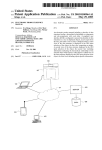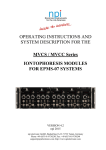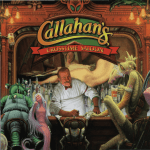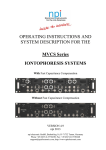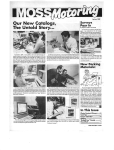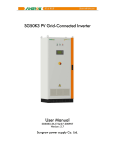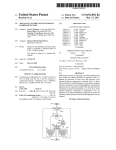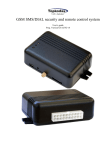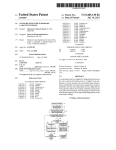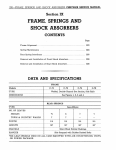Download Electronic product/service manual
Transcript
US006975909B2 (12) United States Patent (10) Patent N0.: (45) Date of Patent: Kluge et al. (54) ELECTRONIC PRODUCT/SERVICE 5,794,257 A * 5,864,480 A * 6,438,535 B1 * MANUAL (75) Inventors: Eva Kluge, Munich (DE); Marc Ho?'man, Neubiberg (DE); Werner Posch, Oberhaching (DE) (73) Assignee: Critical Reach, AG, (DE) (*) Notice: 8/1998 1/1999 8/2002 US 6,975,909 B2 Dec. 13, 2005 Liu et al. ............... .. 715/501.1 Ladd ...................... .. 700/83 Benjamin et al. . .... .. 707/2 6,453,687 B2 * 9/2002 Sharood et al. 62/127 6,559,882 B1 * 5/2003 348/61 6,567,079 B1 * 5/2003 Smailagic et al. 6,606,544 B2 * 8/2003 Kerchner ........... .. 345/184 Glenn et al. ................. .. 701/3 * cited by examiner Primary Examiner—Anthony Knight Subject to any disclaimer, the term of this patent is extended or adjusted under 35 Assistant Examiner—Thomas Pham U.S.C. 154(b) by 662 days. (74) Attorney, Agent, or Firm—Baker & Hostetler LLP; Burman Y. Mathis (21) Appl. No.: 10/002,614 (22) Filed: (57) ABSTRACT Nov. 29, 2001 An electronic product manual including a plurality of data Prior Publication Data (65) US 2003/0100964 A1 (51) (52) Int. Cl.7 structures having a hierarchical relationship as components and sub-components With each other. A graphical user May 29, 2003 ........................ .. US. Cl. ...................... .. interface (GUI) is con?gured to present the plurality of data G05B 15/00 700/83; 707/100; 707/101; 707/102; 707/103 R; 707/103 Y; 707/103; 707/103 Z; 707/104.1; 700/88 (58) Field of Search ............................ .. 700/83; 701/3; 345/184; 707/2, 101, 102, 103 R, 103 Y, 707/103, 104.1, 100 References Cited (56) structures to a user as displayed objects, receive input from the user, and enable a user to select a displayed object. A?rst vieW of the data structure is displayed in the GUI upon selection of the object, the ?rst vieW comprising an image. A second vieW of the data structure displayed in the GUI upon selection of the object, the second vieW including information indicating the hierarchical relationship of the selected object With respect to other objects. A third vieW of the data structure displayed in the GUI upon selection of the object, the third vieW including object-speci?c information. U.S. PATENT DOCUMENTS 5,504,674 A * 4/1996 24 Claims, 6 Drawing Sheets Chen etal. .................. .. 705/4 108 L 104 / f 101 (v AF\ R‘ ,/\'/V/\ /1 s )/// 4105 SERVER _/j L/106 U.S. Patent Dec. 13,2005 Sheet 1 0f 6 US 6,975,909 B2 106 @105 SERV 1FIG. U.S. Patent Dec. 13,2005 Sheet 5 0f 6 ~| OZEMQm PZMEDOQ NEOM US 6,975,909 B2 F ZOFO< wPOuEm U.S. Patent Dec. 13,2005 Sheet 6 6f 6 US 6,975,909 B2 w.OE US 6,975,909 B2 1 2 ELECTRONIC PRODUCT/SERVICE to another page. Hyperlinked interfaces enable a user to interact With a document and more readily reach information MANUAL that is of immediate interest rather than folloWing an pre scribed order through a document. HoWever, these prior systems persist in presenting information in a ?at or linear manner that mimics paper-based media. While hyperlinked BACKGROUND OF THE INVENTION 1. Field of the Invention The present invention relates, in general, to computer aided methods of presenting information, and, more particu larly, to softWare, systems and methods for providing three dimensional and tWo-dimensional graphic, interactive prod documents alloW a user to pursue a non-linear ?oW, there has 10 uct and service manuals. easily leverage existing material from marketing materials, 2. Relevant Background Efficient distribution of goods and services often depends on related documentation such as instructions, product manuals and service manuals. As products become more complex, it is useful for consumers to have ready access to 15 CAD ?les, product literature, or other sources that have been previously compiled. For example, a manual can be pro vided in electronic form using most Word processing, pre sentation, spreadsheet, and similar application softWare that information about the products to aide in installation, setup, con?guration, troubleshooting and repair. In an industrial setting, machines are often speci?cally designed for special purpose and involve complex components and subsystems that must be continually maintained and repaired by machine operators. Operators, hoWever, are often not trained enables images and/or media ?les to be embedded in a document. In the case of hyperlinked documents, the docu ment may comprise a plurality of links to other documents or pages of information stored in a database associated With the presentation logic. In either case, the embedded ?les or database either speci?cally for machine maintenance tasks and must refer to contain information specially created for the manual, or copies of pre-existing ?les that have been reformatted or product documentation. Moreover, consumer products such as appliances, automobiles and household machinery are not been, to date, an effective equivalent With graphical information. Importantly, these systems require the manual to be speci?cally compiled in the neW media format, and do not 25 increasingly complex thereby making reference to docu mentation more frequent and important to the consumer. Service professionals that offer setup and repair services for both industrial and consumer products depend on the “re-purposed”. Hence, the database is closely coupled to the presentation logic (e.g., a Web server) of the manual rather than being coupled to the business processes that produce the product, provide the service, or generate the documen availability of effective, up-to-date documentation. To be tation. As a result, the database copies tend to become out of date With respect to the most current product information. A effective, the documentation must be easy to use and avail need exists for systems and methods for integrating existing able as Well as aid the service professional’s ability to databases With a product manual user interface so that the product manual presents the most relevant information to a perceive, diagnose, and correct problems. Up-to-date docu mentation means that the documentation must cover not only the current version of a product, but also non-current versions that may require service for decades. user. 35 Three-dimensional rendering and imaging is an effective technique for conveying information for many products and The art and science of documentation involves commu services. Three-dimensional images assist users and service nicating information, often very speci?c and focused infor technicians in identifying components and manipulating/ mation, about complex products and systems. Complex products and machines are typically made from arrange 40 ments of simpler piece-parts, components and systems. The components themselves may comprise sub-components and subsystems. In the ?nal product, these assembled sub components de?ne spatial relationship to each other that operating machinery and tools in a Way that plane vieWs do not. Accordingly, many product and service manuals include three-dimensional illustrations. HoWever, existing three-di mensional illustrations fail to alloW user interaction by selection and manipulation of three-dimensional objects. Essentially, the images provide a ?xed vantage point, ?xed dictate hoW the product looks as Well as a functional 45 function informational display that does not enable user to interface With the manual through the three-dimensional image. Hence, a need exists for a product and service manual having a three-dimensional graphical user interface. relationship With each other. Each component has a set of information associated only With that component (e.g., repair instructions, ordering information, and the like) as Well as information about its relationship With other com One of the reasons three-dimensional user interfaces have ponents (e.g., part A is engaged to part B using a 5/16“ bolt not be Widely deployed is that users can actually become and locknut). disoriented When vieWing and navigating about complex Existing documentation systems are inadequate to alloW a user to ef?ciently interact With visual information and rela systems vieWed in three dimensions. Changing Zoom and perspective can readily disorient the user forcing them to back out to a familiar perspective and restart their navigation tionship information to isolate the speci?c and focused information needed at a particular instant from the mass of 55 process. Accordingly, there is a need for a three-dimensional documentation provided for an entire product. Traditionally, product information has been distributed in paper form by Way of brochures, manuals, instruction booklets and the like. product and service manual that enables easier, intuitive navigation of complex systems. One important type of interaction that is needed in con junction With service and product manuals relates to inter Paper is a limited media in Which to present information relating to products and systems because it only presents tWo active messaging and parts ordering. Whether being used by dimensions and is only presented linearly. This forces a user to become very familiar With the paper product to be able to index through it quickly, or to frequently reference an index an end-user or service technician, once a particular compo nent of a system is identi?ed more information about that component may be desired. For example, local sources for or table of contents to ?nd desired information. More recently, this type of information is provided in electronic form including hyperlinked documents that alloW a user to select objects on one page and automatically jump 65 a part and/or inventories of a part may be desired. In some cases, a part may need to be ordered and/or delivered to replace a Worn or defective part. In other instances, the manual user simply needs more information such as material US 6,975,909 B2 3 4 composition, speci?cations, or up-to-date troubleshooting types of data about the product or service Where each type of data included may only be relevant in limited set of contexts. For example, the unit data model may include information. Conventional non-interactive manuals in either paper or electronic form may provide customer service telephone numbers, or Web site addresses and even links to graphical representations of a product, ordering and ship ping data, repair data, operation data, troubleshooting data Web sites that provide further information, but lack sophis ticated inventory, ordering, and messaging interfaces that enable interaction betWeen a user and an external support and the like in a single data structure. In a preferred implementation, the unit data model is implemented as a service such as a parts supplier or manufacturing customer data structure Without any associated behavior or program service representative. Conventional static manuals vary signi?cantly in the amount of information that is contained therein, trying to balance the need for comprehensive information against the elements. In a less preferred alternative implementation, the 10 unit data model is embodied in an object-oriented structure called a unit data object that includes not only the unit data model itself, but generic methods that expose the unit data model data for access by external applications. need to make the manual compact and easy to use. This balance is required because in any given situation, a manual The present invention also involves a graphical user provides much more information that is needed to solve a 15 interface (GUI) application con?gured to access the unit object. The GUI application is preferably con?gured for a problem at hand. Aneed exists for methods and systems for delivering product manual information as needed and requested by a user. particular context related to the role of the user operating the GUI application. This con?guration may be static or dynamic (e.g., the application implemented on a loading SUMMARY OF THE INVENTION 20 dock can be statically de?ned to that role Whereas a broWser application may be dynamically con?gured for various roles Brie?y stated, the present invention involves an electronic product manual including a plurality of elements having a hierarchical relationship as components and sub-compo depending on the user identi?cation. Because the GUI application can access any of the various types of data from the unit data structure, the unit data structure is readily nents With each other. A data structure stores data of various 25 shared across the various GUI application instances, and is types representing the components and sub-components. A graphical user interface (GUI) is con?gured to present accessible by the various methods of displaying data that are implemented Within any GUI application. selected portions of the data structure to a user, receive input The rich and varied nature of the data contained in the unit data structure alloWs the combination of interactive tWo from the user, and enable a user to select an object from the display. A ?rst vieW of the data structure displayed in the GUI upon selection of the object, the ?rst vieW comprising an image of the object. A second vieW of the data structure is displayed in the GUI upon selection of the object, the second vieW including information indicating the hierarchi cal relationship of the selected object With respect to other objects. A third vieW of the data structure displayed in the GUI upon selection of the object, the third vieW including 30 information such as hierarchical views. Preferably, a GUI 35 object-speci?c information. BRIEF DESCRIPTION OF THE DRAWINGS dimensional and three-dimensional graphics With interactive text describing the graphics and interactive product structure application displays disparate vieWs of the relevant unit data model simultaneously such that, for example, a graphical vieW is displayed along side a text description and/or hierarchical display of the product represented by the unit data model. Preferably, each of the displayed vieWs is interactive such that a user may selected a particular portion or element that is displayed and cause the GUI application 40 to implement a programmed behavior. The programmed behavior may, in many instances, update one or more of the FIG. 1 shoWs an computer environment in Which the displayed vieWs to shoW more or less detail or a neW present invention is implemented; perspective of the product associated With or represented by FIG. 2 illustrates a ?rst representation of a user interface of an electronic manual in accordance With the present the unit data structure. 45 invention; A particular implementation of the present invention involves use of three-dimensional graphics to display por tions of the unit data model. One aspect of the present FIG. 3 illustrates a second representation of a user inter face of an electronic manual in accordance With the present invention uses an ef?cient and expedient method for embed invention; ding component identi?cation information into the frame buffer of the display device itself so that it is readily manipulated using operating system methods that are already available in most commercial operating system softWare. This method is described in co-pending US. patent application Ser. No. 10/001,940 assigned to the assignee of the present invention and entitled “SYSTEM FIG. 4 illustrates a third representation of a user interface 50 of an electronic manual in accordance With the present invention; FIG. 5 shoWs components of a unit data structure used to implement the electronic manual in accordance With the present invention; and 55 FIG. 6 is an exemplary markup language document used to implement a particular instance of a unit data structure in AND METHOD FOR IMPLEMENTING A THREE-DI MENSIONAL GRAPHIC USER INTERFACE” and incor accordance With the present invention. porated herein by reference. As noted above, a key limitation of online manuals is their DETAILED DESCRIPTION OF THE PREFERRED EMBODIMENTS An important feature of the present invention is the incorporation of a truly interactive graphical user interface 60 failure to shoW information that is relevant to a user at runtime. By the terms “user-relevant information” and “user-centric information”, it is meant that the perspective and content of three-dimensional data matches the perspec tive and content desired by a user. This may also be referred (GUI). The present invention involves creating a single 65 to as “context-sensitive” display as the content that is comprehensive representation of a product or service called displayed and the manner in Which the content is displayed a “unit data model”. The unit data model includes various may vary depending on the user’s current context. While US 6,975,909 B2 5 6 various techniques have been used to display these different types of data in the past, these prior approaches involved multiple separate and independent data structures such that so that a part being vieWed can be animated to shoW normal and/or malfunctioning operation. Other features of the present invention involve the de? nition of default perspectives With the unit data structures. It has been found that one limitation of truly interactive each data structure held data that Was relevant to a particular user, role or context. In contrast, the present invention enables a single data structure, the unit data structure or unit object, that can be shared across these disparate users, roles and contexts. In the case of non-graphical data, user-relevant data means that the data is current and applicable to the real World system corresponding to the manual. The vast quan three-dimensional graphical user interfaces is that a user may become disoriented or lost. This has not been a problem in prior systems that have static data presentation because tity of potential information forces conventional systems to the user could not manipulate the perspective and content presented in a vieW. In accordance With the present inven tion, upon initial selection of an object a default perspective or starting point is presented in one or all vieWs of the truncate the available information both in content and in the graphical user interface. A user can then manipulate the presentation logic used to present the data. This, in turn, limits the ability of the manual to present relevant vieWs, relevant perspectives in those vieWs, relevant animation, relevant troubleshooting information. As a result, product 10 object from the de?ned starting point, and may preferably 15 FIG. 1 shoWs an exemplary netWorked computer envi ronment in Which the present invention is implemented including various computing devices such as personal com and service manuals are generally if not exclusively machine centric or product centric in that they provide information having content and perspective selected by the system, not puter 102, Wireless hand-held device 103, and laptop 104 interconnected by a netWork 101. In one embodiment, an the user. The unit data structure in accordance With the present invention enables incorporation of data from exter nal databases and so can access and present data at runtime, alloWing a virtually unlimited amount of data that can be formatted and presented to satisfy the current demands of a return to the default perspective as desired. 25 appliance such as Washing machine 107 includes a netWork connection, and/or a connection to another computing device such as device 104. Appliance 107 could be any type of appliance, machine, or system Which is the subject of a product/service manual in accordance With the present invention. In the particular example of FIG. 1, appliance 107 user. By Way of a particular example, the external interfaces includes an integrated display device for use With a graphi may include a link to dynamic external sources such as cal user interface, hoWever, this capability is optional. interfaces for ordering components and parts. The most It should be understood that the present invention does not require a netWork environment, nor netWork connectivity to advance systems available to date may include a phone number or online order tool for an entire system. For example, an appliance manufacturer may include a Web link appliances such as appliance 107. In fact, because the present invention can greatly ease the hardware require ments needed to provide a three-dimensional product manual, it enables stand-alone operation of devices such as that Would alloW a user to order a neW timing belt or bolt from the appliance manufacturer. In contrast, some embodi ments of the present invention enables an application to 35 implement an order interface on an object-by-object basis. Hence, an entry in the data structure representing a drive belt for a Washing machine include information providing a link to the Washing machine manufacturer, or a link to a local appliance dealer, hardWare store, or belt manufacturer. In hand-held device 103 and/or appliance 107 With relatively little computing poWer. HoWever, for this same reason the present invention enables client-server computing systems in Which computationally intensive graphical processes and/ or database operations are conducted on a server 105. In 40 this manner, the order interface can be relevant to the user’s immediate needs. Apreferred implementation enables a user to submit the order directly in the manual and transfer the order using server side processes directly in the vendors such systems, end-user devices 101—104 and 107 may implement only a graphical user interface, or may imple ment any desired subset of the graphical processes used to render and manipulate graphical user interface objects. Each of the devices shoWn in FIG. 1 may include memory, advantages of this implementation include unambiguous mass storage, and a degree of data processing capability suf?cient to manage the display of information using a spare part identi?cation and ordering. Alternatively the order display device and manage a netWork connection Where one can added to a shopping cart, that is maintained in a is implemented. The computer program devices in accor dance With the present invention are implemented in the memory of the various devices shoWn in FIG. 1 and enabled backend system (eg SAP R/3) to process the order. Some e-commerce system. Some systems (e.g., Commerce One, Websphere Commerce Suite) have standard interfaces (“roundtrip”, “punch out”) that can be accessed by a external applications such as the present invention to identify spare parts. In this manner, the preferred implementations enable ef?cient and accurate parts ordering directly from the manual application in accordance With the present invention. Another example of the presentation of user-relevant 45 by the data processing capability of the devices shoWn in FIG. 1. In addition to local memory and storage associated With each device, it is often desirable to provide one or more locations of shared storage such as data store 106 that 55 device can ef?ciently use and manage. Selected components of the present invention may be stored in or implemented in data store 106. FIG. 2 illustrates an exemplary user interface presented in information involves the use of animation in the graphical user interface. Automobiles, appliances, and other devices that use microcontrollers often include failure lights that blink in a particular pattern to indicate particular types of trouble. Including animation sequences for each of the potential failure modes Would require a signi?cant amount of data and programming, much of Which Will never be used (assuming that, in general, the appliance systems do not fail). In accordance With the present invention, complex presentation methods such as animation sequences can be requested by a user of the manual and provided on demand provides mass storage capacity beyond What an individual a WindoWed environment such as is familiar to many per sonal computer users. Non-WindoWed graphical user inter face environments can readily be adapted to the present invention as Well. The particular examples herein use a Web broWser as a graphical user interface to leverage softWare 65 that is common across many computing platforms, hoWever, any type of graphical user interface is readily substituted. A user is enabled to interact With the graphical user interface US 6,975,909 B2 7 8 using a pointing device such as a mouse, pen, stylus, structure in the sense that the high level data structure touch-screen monitor or tablet that enables a user to position a cursor 204 over a desired location anyWhere in the includes references to the loWer level object. For example, the sub-unit data structure corresponding to graphical user interface and select an object at that location. As shoWn in FIG. 2, the graphical user interface 200 preferably includes at least one WindoW, pane, frame or the control panel is presented in the three-dimensional image portion 201, the hierarchical portion 202, and the informa portion 201 allocated to displaying a graphical (i.e., tWo- or three-dimensional representation) of a product that is the subject matter of the product/service manual in accordance With the present invention. An object is indicated by, for tion portion 203. A user can select any of the presentation information corresponding to the control panel data structure With a similar result on the entire display. A user can also 10 example, ?oating the cursor over a particular location. In a A user can select a sub-unit data structure by positioning the cursor over one of the representations of the sub-unit particular embodiment, the object identi?cation information is obtained from the frame buffer and a tool tip 206 is displayed as shoWn in FIG. 2. In many cases the tool tip information may simply comprise a name for the component under the cursor, hoWever, any amount of information may be included in the tool tip. As the cursor is moved from one location to another, as suggested by the dashed-line arroW in data structure in any of portions 201, 202 or 203. Some sub-unit data structures may be presented in only one of the 15 portions 201—203, Whereas other sub-unit data structures may be presented in a plurality of or all of the portions 201—203. Because all of the information presented in the various vieWs shoWn in FIG. 2 are inherently related because they are aggregated into a single unit data structure, they are highly coordinated and easy to program, maintain, and use. A design change to a neW lint ?lter, for example, need only affect a lint ?lter data structure and the upper-level data FIG. 1, the displayed tool tip changes to indicate the object identi?cation of the object currently under the cursor. In addition to the three-dimensional image vieW, the present invention preferably includes a hierarchical vieW 202 and an information vieW 203. Hierarchical vieW 202 communicates the hierarchical relationship of a currently selected object With respect to parent and child components. manipulate the perspective and Zoom level on the image portion 201 Without changing the selected data structure. structures Will automatically incorporate the changes. More 25 For example, the control panel is a component or child of the entire Washing machine. The control knob is a child of the over a user Will only be presented With the detailed infor mation about a sub-component if and When that sub-com ponent is selected. Hence, only information relevant to a particular user in a particular instance need be communi control panel. Preferably this hierarchical relationship is conveyed using positioning, colors, or other visual cues that suggest a hierarchical relationship. The hierarchical vieW cated to the user. 202 presents one or more branches of the component and also contemplates that at least some unit data structures Will sub-component relationships that exist in the real World include animation sequences that Will illustrate certain actions and functionality. For example, selection of the “access lint ?lter” entry in the information WindoW may launch an animation sequence describing hoW the porthole door is operated as shoWn in FIG. 4. Conveniently, the animation selects the “lint ?lter” data structure, displays the Although not capable of illustration, the present invention system or device. The hierarchical vieW 202 aids the user in understanding a particular system being examined, and is a navigational expedient as components are explored. 35 Information vieW 203 includes a number of variable components that provide information relevant to a selected object. In the representation of FIG. 2, the entire Washing animation in image portion 201 and displays useful infor machine is selected at a gross perspective, and the informa tion vieW presents data or links to data about available mation such as ?lter ordering information and lint-?lter 40 speci?c troubleshooting information in the information Win doW. documentation, features and the like. Functionality available at the gross level is also presented, as are actions that a user A user can select a particular data structure by pressing a can perform on the selected object. Functionality refers to normal and/or abnormal functions that the machine or system Will perform. Actions refer to things the user can do to manipulate or operate the selected object. As described more fully beloW, as sub-components of the system are mouse button, keyboard button, or similar indicating device. Selection of an data structure results in updating of all the 45 frames as shoWn in FIG. 3 to present information corre sponding to the selected data structure. For example, the three-dimensional image portion may Zoom or reorient to a selected, the set of available functions, actions, and docu default perspective for the selected data structure While the mentation changes to be relevant to the user-indicated need. hierarchical frame Will focus on a branch corresponding to the selected data structure and the information frame Will In some applications, error conditions associated With a particular selected object are also displayed as shoWn in display documentation, functionality, actions, error condi FIG. 1. Error conditions are conditions that are knoWn to tions and/or order information speci?c to the selected com occur With respect to a selected object and are again speci?c to the particular object selected. At the gross level shoWn in ponent. As shoWn in FIG. 3, another useful display in the information portion is product order information that is tailored to the speci?c component corresponding to the FIG. 2, some very high-level error conditions may be presented such as lack of poWer to the machine, and the like. 55 particular data structure. Other information such as error Preferably, all of the information presented in a particular conditions, functionality, and actions speci?c to the selected vieW such as shoWn in FIG. 2 is associated With a single unit data structure that contains any number of sub-unit data component can be displayed. Any number of hierarchical levels can be incorporated in this manner. HoWever, this level of ?exibility sometimes structures corresponding to particular sub-components of the real World system. The unit data structure corresponding to the entire Washing machine is the highest-level data results in a user becoming disoriented or lost in a particular structure in the particular example. The highest-level unit data structure includes links or interfaces to a control panel unit data structure, a control knob data structure, a digital display data structure, a porthole data structure and the like. These sub-components are contained in the high level data 65 spatial vieW or branch. One feature of the present invention is that each of the data structures includes default presen tation information that includes default content, including default spatial perspective as Well as default content in any other vieWs When the object is initially selected. The default vieW constrains the user interface in a manner that discour US 6,975,909 B2 9 10 ages disorientation, but allows the user to continue to tunnel doWn into an data structure from the default content. This face (GUI) for displaying one or more vieWs of the unit data structure, and so provides differing perspectives of the underlying data model. feature also promotes better cognition of a problem condi The GUI application is preferably implemented indepen tion by a user by ensuring that the user is aWare of inter acting components and sub-components during an investi dently of the data model implemented by the unit data gation. structure. In other Words, methods for creating displays are FIG. 5 illustrates an exemplary unit data structure used in the present invention. The unit data structure acts to aggre not Within the unit data structure itself, but instead are gate or contain data of disparate types, and make available application. The data structure de?nition de?nes a variety of behavior out of the data model enables the application to provide several vieWs to the same underlying data. This feature enables “role-based” data access. By role information types including CAD design ?les, 3D graphics ?les, marketing materials, product descriptions, etc. based data access it is meant that the manner in Which data is displayed can be varied based on the role of the user, implemented in the GUI application. Keeping the GUI the disparate data to a user via a graphical user interface Without changing the underlying data model. For example, Each unit data structure also has a prede?ned “default” presentation information in one or more of the vieWs 15 the service technician has access to maintenance and diag nosis vieWs Whereas terminals offer only logistic data like availability and storage location of spare parts. In this manner, a single comprehensive data structure, the unit data described above. In operation, When a unit data structure is ?rst selected, the prede?ned default presentation informa tion are displayed. This is most apparent in the graphical vieW in Which the dfault presentation information includes a structure, can be shared and leveraged across multiple roles. Each unit data structure includes a quantity of object speci?c data such as a de?nition of the default perspective of that particular unit object, as Well as data indicating the hierarchical relationship of the speci?c unit data structure to default perspective in Which vieWpoint, magni?cation, rota tion, and the like may be prede?ned by default presentation information to guide the user to a selected part. Additionally, highlighting to indicate the selected part With any kind of pointers, colors, different shading, positioning, hiding non selected surrounding parts, transparency, text, sound and the 25 used to identify the contained sub-unit data structures for use in GUI application processes that access external databases and/or access sub-unit data structures. Some of the interfaces shoWn in FIG. 5 may be null for a particular unit data structure. For example, there may be no user-initiated actions that can be taken on a particular product component, like may be included in the default presentation information to determine other features of the graphical information display that may be useful to a user’s ready understanding of the information being presented. Any default presentation information may be used that aid a user in understanding What is being vieWed in relation to and so the particular unit data structure representing that other system components, including text, graphics, sound, or other information that aides the user in this goal. This aids signi?cantly in navigation as the user does not get lost in the graphical vieW(s) When selecting parts of a complex system. product or component Will not have data related to Actions. As illustrated in FIG. 5, animation sequence(s) data may 35 Which to begin understanding information in the other vieW frames. In total, this has an effect of making it much easier for the user to reach a cognitive understanding of What is be included in the unit data structure and linked to particular functionality or actions that can be performed With or on the component corresponding to the unit data structure. A user may select a particular machine function and the GUI application Will obtain the animation data an play an ani This also ensures that the user has a knoWn perspective from being displayed, a great advantage for user manuals. Unit data structure 500 provides linking betWeen the various disparate data types so that When an object is selected via one of the data types, the presentation of the other data types can be updated automatically to continue the integrated presentation. This linking is often implicit as other data structures (e.g., external databases, sub-unit data structures, and the like). The hierarchical information can be 40 mation intended to illustrate proper and/or malfunctioning behavior for the component. Similarly, an animation may illustrate an action to be performed such as tightening a screW or replacing a belt. The animation sequences can be used interactively With the error state data such that for a 45 particular error state, speci?c actions are prescribed and animations presented, as implemented by the GUI applica the different displayed vieWs of the data structure are all referencing the same data model. Hence, a “starter motor” can be displayed graphically, textually, and as a part of a tion. Once the prescribed actions are performed by the user, hierarchical listing of components, but each displayed vieW invention enables interactive, situation-speci?c trouble is referencing the same data model. Accordingly, When a user selects an armature Winding, irrespective of Whether the shooting. Winding is selected via the graphical display, text display or hierarchical display, the same portion of the unit data model is referenced to provide data to the GUI application for implementation in accordance With the present invention the error state can once again be revieWed to determine if an error condition has been resolved. In this manner, the present FIG. 6 illustrates a highly simpli?ed unit data structure including image rendering information, ordering informa 55 implementing behavior in response to the selection event. In this manner, the electronic manual in accordance With the present invention is readily linked to external databases to provide current, user-centric information to a user Without tion, and documentation information. As shoWn in FIG. 6, the unit data structure in accordance With the present inven tion is readily implemented in a markup-language document such as an XML document or the like. It is contemplated that almost any data structure including one or more tables in a the large overhead normally associated With having that ?at or relational database, or other available data structure extent of information present on the user’s machine. could implement a unit data structure. This alloWs the unit data structure to be highly portable in that it can be displayed In the particular example, a “unit data structure” (shoWn in greater detail in FIG. 5) is de?ned that can be used both to contain other data structures and to include object-speci?c information. The unit data structure implements a data model used to store all information provided by a manual application. The application provides a graphical user inter on a Wide variety of devices and graphical user interface programs. 65 Although the invention has been described and illustrated With a certain degree of particularity, it is understood that the present disclosure has been made only by Way of example, US 6,975,909 B2 11 12 and that numerous changes in the combination and arrange ment of parts can be resorted to by those skilled in the art 9. The product manual of claim 1 Wherein at least one of the plurality of data structures includes a pointer to an external data store having current information. Without departing from the spirit and scope of the invention, as hereinafter claimed. For example, the present invention may enable an interactive product/service manual to be embedded into a system or appliance. Embedded systems 10. The product manual of claim 1 further comprising: 5 a user-selected object from the plurality of displayed objects in one of the ?rst, second, and third vieWs; Wherein the GUI is con?gured to alloW updating of the ?rst, second, and third vieWs in response to the user’s are necessarily very simple and constrained in the type and quantity of information that can be presented to a user. A manual that requires signi?cant computational resources to run Would increase the cost and complexity of the appliance. Because the present invention can be provided in a relatively compact form, all or part of the present invention may be embedded in an appliance itself. Because data and program code needed at runtime can be dynamically accessed, the system in accordance With the present invention can be effectively run on a moderately complex microprocessor. a selection tool operable to receive user input and indicate selection of an object. 11. The product manual of claim 10 Wherein each of the plurality of data structures de?nes a default perspective and the act of updating the ?rst, second and third vieWs com prises presenting the default perspectives. 15 12. A display object for product manual having a graphi cal user interface, the display object corresponding to a real-World component of a system, the display object com These and other extensions, equivalents, and applications of the present invention are encompassed by the folloWing prising: claims. a link to a unit data structure; ?rst presentation means initiated in response to selection We claim: 1. An electronic product manual stored in a computer of the displayed object and operable to retrieve an image of the display object from the unit data structure and display the image using the graphical user inter readable medium comprising: a plurality of data structures, each data structure holding data representing a product and having a hierarchical relationship as components and sub-components With face; 25 second presentation means initiated in response to selec tion of the displayed object and operable to retrieve a hierarchical vieW from the unit data structure and each other; selected from the plurality of data structures to a user display the hierarchical vieW using the graphical user interface; and in the form of displayed objects, receive input from the third presentation means initiated in response to selection user, and enable a user to select data from the plurality of the displayed object and operable to retrieve a information about the real-World component from the unit data structure and display the information using the a graphical user interface (GUI) con?gured to present data of data structures by selecting a displayed object; a ?rst vieW of the selected data structure displayed in the GUI upon selection, the ?rst vieW comprising an image of the selected object; graphical user interface. 35 selection means operable to retrieve selected data from the unit data structure in response to user input indi a second vieW of the selected data structure displayed in the GUI upon selection, the second vieW including information indicating a hierarchical relationship of the 40 cated selection of the displayed object. 14. The display object of claim 12 further comprising ordering means implementing a product ordering interface for ordering the real-World component. 15. The display object of claim 12 further comprising 45 tation database from the unit data structure and accessing the documentation database containing documentation associ ated With the real-World component. selected data structure With respect to other data struc tures; and a third vieW of the selected data structure displayed in the GUI upon selection, the third vieW including compo documentation means for obtaining a pointer to a documen nent-speci?c information. 2. The product manual of claim 1 Wherein the ?rst, second and third vieWs of the selected data structure are displayed simultaneously. 16. The display object of claim 12 further comprising 3. The product manual of claim 1, Wherein the graphical functionality means for accessing a description of function ality of the real-World component from the unit data struc user interface is con?gured to enable selection of any displayed object from any of the ?rst, second and third ture. vieWs. 4. The product manual of claim 1 Wherein the ?rst vieW 17. The display object of claim 12 further comprising actions means for accessing a description of actions that are comprises a three-dimensional image of the selected object possible to perform on the real-World component from the having user-selectable sub-components. 5. The product manual of claim 1 Wherein the ?rst vieW further comprises help information obtained from the unit data structure. 55 structure. 19. The display object of claim 12 further comprising: animation methods coupled to communicate With the actions means for retrieving animation sequence data from the unit data structure and generating an anima tion depicting the actions on the graphical user inter face. tionship. plurality of data structures includes data types relevant to the ?rst, second and third vieWs. 18. The display object of claim 12 further comprising error state means for accessing a description of potential error states for the real-World object from the unit data selected data structure associated With a particular displayed object and made visible in the ?rst vieW When user input indicates a focus on the particular displayed object. 6. The product manual of claim 1 Wherein the second vieW comprises a tree structure depicting the hierarchical rela 7. The product manual of claim 1 Wherein the third vieW presents ordering information relevant to the selected object. 8. The product manual of claim 1 Wherein each of the 13. The display object of claim 12 further comprising: 65 20. The display object of claim 12 further comprising: animation means coupled to communicate With the func tionality methods for retrieving functionality data from US 6,975,909 B2 14 13 the unit data structure and generating an animation essentially of documentation, ordering information, depicting the functionality on the graphical user inter face. error states and animation; graphical display information, functionality, actions, 21. The display object of claim 12 further comprising data organiZing the information into sets of information related structures Within the unit data structure for indicating rela to particular components and sub-cornponents Within tionships betWeen the display object and other, external display objects, Wherein the relationships rnirror relation ships betWeen real-World components. the particular product; de?ning a unit object data structure to hold data related to a particular cornponent irrespective of the data type; 22. The display object of claim 12 Wherein the unit data and using data from the unit data structure of an initial structure includes a de?nition of a default perspective for the display object in each of the ?rst, second, and third presen component to generate a graphical user interface cor tation methods. 23. A method for displaying a product manual for a responding to the unit data structure and presenting user-selectable links to sub-cornponent unit data struc particular product, the product comprising a plurality of components and sub-cornponents, in an interactive graphical user interface, the method comprising the acts of: gathering resources related to the product and its compo nents and sub-cornponents, the information including information of types selected from the group consisting tures. 15 24. The method of claim 23 further comprising the act of using the ?rst instance to instantiate subsequent instances of the unit object class for selected sub-cornponents. * * * * *














